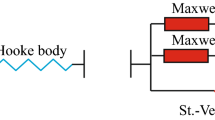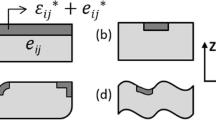Abstract
Constitutive equations were calibrated to improve their application in assessing a stress field in front of a crack under the conditions of large strains and stress triaxiality. The Bai-Wierzbicki method was adopted, and certain changes and new terms were introduced to incorporate material softening. Five shapes of specimens were tested to cover a wide range of stress triaxiality conditions and Lode factors. Tests were performed at three different temperatures, namely, +20 °C, -20 °C, and -50 °C, and on three different materials obtained by three different heat treatments of S355JR steel.
Similar content being viewed by others
References
N.P. O’Dowd, C.F. Shih, Family of crack-tip fields characterized by a triaxiality parameter — I. Structure of fields, J. Mech. Phys. Solids 39 (1991) 898–1015.
A. Neimitz, J. Galkiewicz, Fracture toughness of structural components. Influence of constraint, Int. J. Pressure Vessels Piping 83 (2006) 42.
A. Neimitz, M. Graba, J. Galkiewicz, An alternative formulation of the Ritchie-Knott-Rice local fracture criterion”, Eng. Fract. Mech. 74 (8) (2007) 1308–1322.
A. Neimitz, I. Dzioba, The influence of the out-of-plane and in-plane constraint on fracture toughness of high strength steel in the ductile to brittle transition temperature range, Eng. Fract. Mech. 147 (2015) 431–448.
N. Beremin, A local criterion for cleavage fracture of a nuclear pressure vessel steel”, Metal. Trans. A 14A (1983) 2277–2287.
G. Rousselier, Ductile fracture models and their potential in local approach to fracture, Nucl. Eng. Des. 109 (1987) 97–111.
F. Mudry, A local approach to cleavage fracture Nucl. Eng. Des. 105 (1987) 65–76.
S.R. Borodet, A.D. Karstensen, D.M. Knowles, C.S. Wiesner, A new statistical local criterion for cleavage fracture in steel. Part I: Model presentation” Part II: application to an offshore structural steel, Eng. Fract. Mech. 72 (2005), 435–452 (Part I), pp. 453–474 (Part II).
A. Pineau, Development of the local approach to fracture over the past 25 years; theory and applications, Int. J. Fract. 138 (2006) 139–166.
X. Gao, C. Ruggieri, R.H. Dodds, Calibration of Weibull stress parameters using fracture toughness data, Int. J. Fract. 92 (1981) 75–200.
X. Gao, R.H. Dodds, Constraint effects on the ductile-to-cleavage transition temperature of ferritic steels: a Weibull stress model, Int. J. Fract. 102 (2000) 43–69.
X. Gao, R.H. Dodds R.L. Tregoning, J.A. Joyce, R.E. Link, A Weibull stress model to predict cleavage fracture in plates containing surface cracks, Fatig. Fract. Eng. Mater. Struct. 22 (1999) 481–493.
X. Gao, R.H. Dodds, An engineering approach to assess constraint effects on cleavage fracture toughness, Eng. Fract. Mech. 68 (2001) 263–283.
A.L. Gurson, Continuum theory of ductile rupture by void nucleation and growth: part I — yield criteria and flow rules for porous ductile media, J. Eng. Mater. Technol. 99 (1977) 2– 15.
C.C. Chu, A. Needleman, Void nucleation effects in biaxially stretched sheets, J. Eng. Mater. Technol. 102 (3) (1980) 249– 256.
V. Tvergaard, A. Needleman, Analysis of the cup-cone fracture in a round tensile bar, Acta Metall. 32 (1) (1984) 157–169.
J.B. Leblond, G. Perrin, J. Devaux, An improved Gurson-type model for hardenable ductile metals, Eur. J. Mech. — A/Solids 14 (2) (1995) 499–527.
T. Pardoen, J.W. Hutchinson, An extended model for void growth and coalescence, J. Mech. Phys. Solids 48 (2000) 2467– 2512.
A. Benzerga, J. Besson, A. Pineau, Anisotropic ductile fracture part ii: theory, Acta Mater. 52 (2004) 4639–4650.
K. Nahshon, J.W. Hutchinson, Modification of the Gurson model for shear failure, Eur. J. Mech. – A/Solids 27 (2008) 1–17.
K.L. Nielsen, V. Tvergaard, Ductile shear failure of plug failure of spot welds modeled by modified Gurson model, Eng. Fract. Mech. 77 (2010) 1031–1047.
Y. Bao, T. Wierzbicki, On fracture locus in the equivalent strain and stress triaxiality space, Int. J. Mech. Sci. 46 (1) (2004) 81–98.
Y. Bai, T. Wierzbicki, Application of extended Mohr–Coulomb criterion to ductile fracture, Int. J. Fract. 161 (2010) 1–20.
Y. Bai, T. Wierzbicki A new model plasticity and fracture with pressure and Lode dependence, Int. J. Plast. 24 (2008) 1071–1096.
M. Algarni, Y. Bai Y. Choi, A study of Inconel 718 dependency on stress triaxiality and Lode angle in plastic deformation and ductile fracture, Eng. Fract. Mech. 147 (2015) 140–157.
D. Mohr, S.J. Marcadet, Micromechanically-motivated phenomenological Hasford–Coulomb model for predicting ductile fracture initiation at low stress triaxialities, Int. J. Solids Struct. 67–68 (2015) 40–45.
Author information
Authors and Affiliations
Corresponding author
Rights and permissions
About this article
Cite this article
Neimitz, A., Galkiewicz, J. & Dzioba, I. Calibration of constitutive equations under conditions of large strains and stress triaxiality. Archiv.Civ.Mech.Eng 18, 1123–1135 (2018). https://doi.org/10.1016/j.acme.2018.02.013
Received:
Accepted:
Published:
Issue Date:
DOI: https://doi.org/10.1016/j.acme.2018.02.013




